Search Thermo Fisher Scientific
Invitrogen
MHC Class II I-Ab Monoclonal Antibody (AF6-120.1), eFluor™ 450, eBioscience™
FIGURE: 1 / 7
MHC Class II I-Ab Antibody (48-5320-82) in Flow
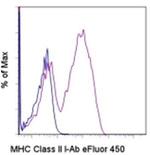
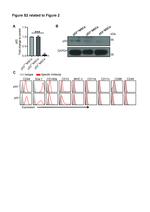
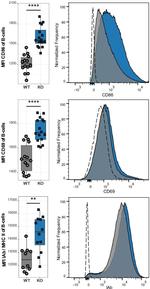
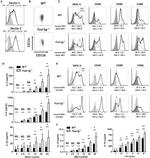

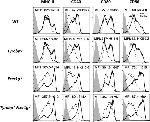
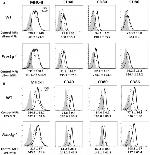
Product Details
48-5320-82
Species Reactivity
Published species
Host/Isotype
Recommended Isotype Control
Class
Type
Clone
Conjugate
Excitation/Emission Max
Form
Concentration
Purification
Storage buffer
Contains
Storage conditions
Shipping conditions
RRID
Product Specific Information
Description: This AF6-120.1 monoclonal antibody reacts with the mouse MHC Class II I-Ab alloantigen of H-2b bearing mouse strains, including C57Bl/6 and 129. This cell surface molecule is involved in antigen presentation to T cells expressing CD3/TCR and CD4.
The AF6-120.1 antibody crossreacts with H-2k and H-2u haplotypes. However, reactivity to other haplotypes (i.e., d, f, g7, p, q, r, and s) has not been observed.
Applications Reported: This AF6-120.1 antibody has been reported for use in flow cytometric analysis.
Applications Tested: This AF6-120.1 antibody has been tested by flow cytometric analysis of mouse splenocytes. This can be used at less than or equal to 1 µg per test. A test is defined as the amount (µg) of antibody that will stain a cell sample in a final volume of 100 µL. Cell number should be determined empirically but can range from 10^5 to 10^8 cells/test. It is recommended that the antibody be carefully titrated for optimal performance in the assay of interest.
eFluor® 450 is an alternative to Pacific Blue®. eFluor® 450 emits at 445 nm and is excited with the Violet laser (405 nm). Please make sure that your instrument is capable of detecting this fluorochrome.
Excitation: 405 nm; Emission: 445 nm; Laser: Violet Laser.
Filtration: 0.2 µm post-manufacturing filtered.
Target Information
I-Ab (H2-Ab1, histocompatibility 2, class II antigen A, beta 1) is an MHC class II heterodimer molecule of non-covalently associated alpha (31-34 kDa) and beta (26-29 kDa) chains. Major histocompatibility complex class II antigen presentation requires the participation of lysosomal proteases in two convergent processes. First, the antigens endocytosed by the antigen presenting cells must be broken down into antigenic peptides. Second, class II molecules are synthesized with their peptide-binding site blocked by invariant chain (Ii), and they aquire the capacity to bind antigens only after Ii has been degraded in the compartments where peptides reside. MHC class II molecules present exogenously derived antigen to CD4+ T lymphocytes, which are usually T helper cells. CD4 interacts with non-polymorphic residues of MHC class II. H2-Ab1 heterodimer chains alpha (DQA) and beta (DQB) are both anchored in the membrane. H2-Ab1 plays a central role in the immune system by presenting peptides derived from extracellular proteins. Class II molecules are expressed in antigen presenting cells (APC: B lymphocytes, dendritic cells, macrophages). The beta chain contains 6 exons. Exon one encodes the leader peptide, exons 2 and 3 encode the two extracellular domains, exon 4 encodes the transmembrane domain and exon 5 encodes the cytoplasmic tail. Within the DQ molecule both the alpha chain and the beta chain contain the polymorphisms specifying the peptide binding specificities, resulting in up to 4 different molecules. Typing for polymorphisms is routinely done for bone marrow transplantation.
HLA and MHC antibodies play a significant role in Immunopeptidomics, facilitating the identification and characterization of neoantigens through high-performance liquid chromatography coupled to tandem Mass Spectrometry.
For Research Use Only. Not for use in diagnostic procedures. Not for resale without express authorization.
How to use the Panel Builder
Watch the video to learn how to use the Invitrogen Flow Cytometry Panel Builder to build your next flow cytometry panel in 5 easy steps.
Bioinformatics
Protein Aliases: CELIAC1; DADB-249P12.2; H-2 class II histocompatibility antigen, A beta chain; H-2Eb; H2Eb; histocompatibility 2, class II antigen A, beta 1; HLA-DQB; Ia-4; Ia4; IDDM1; major histocompatibility complex class II beta chain; MGC163794; MGC163796; MHC class II antigen A beta; MHC class II H2-IA-beta-psi; response to metastatic cancers 1
Gene Aliases: Abeta; AI845868; H-2Ab; H2-Ab; H2-Ab1; H2-iabeta; I-Abeta; Ia-2; Ia2; IAb; Rmcs1
UniProt ID: (Mouse) P14483
Entrez Gene ID: (Mouse) 14961

Performance Guarantee
If an Invitrogen™ antibody doesn't perform as described on our website or datasheet,we'll replace the product at no cost to you, or provide you with a credit for a future purchase.*
Learn more
We're here to help
Get expert recommendations for common problems or connect directly with an on staff expert for technical assistance related to applications, equipment and general product use.
Contact tech support

